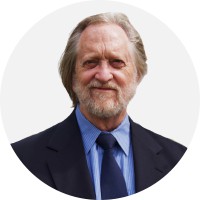The views expressed in our content reflect individual perspectives and do not represent the authoritative views of the Baha'i Faith.
Mothers typically prepare for their birth of a baby—so why wouldn’t we all prepare, in a similar way, for our second birth?
Having examined the Baha’i view of physical creation as a just and logically-devised system in previous essays in this series, we have now responded to the first of three major concerns—the theoretical basis for a belief in some form of divine justice in relation to physical reality, and our individual and collective experience in it. Our second task is to move from theory and theology to practicality—to determine how this environment trains and assists us on a daily basis to know and to worship God:
Out of the wastes of nothingness, with the clay of My command I made thee to appear, and have ordained for thy training every atom in existence and the essence of all created things. – Baha’u’llah, The Hidden Words, p. 22.
This objective should be more immediately satisfying than the first. It would certainly seem to respond more forcefully to the questions raised by Job and Boethius if such a practical analysis could provide insight into how negative experiences and unjust suffering can ultimately lead us to positive conclusions.
In short, it is all well and good to assert eternal providence or to discern a coherent and logical set of laws and principles at work in the universe—but we live our lives one day at a time with family and friends in a community where we must busy ourselves with mundane sorts of activities. In this context, we need to understand how what we do each day—the prenatal exercises for our second birth—can help us have the subjective knowledge of the “end” in what sometimes seems to be a very painful and ludicrous “beginning.”
The Unity of Human Experience
When we let the phenomenal world become an end in itself, rather than a means of gaining access to the spiritual reality it reflects, or when we let our physical or appetitive nature rule over our judgmental or volitional faculties, we are, indeed, in a state of injustice, confusion, and internal strife. In such a state the physical world does become detrimental to our success. But physical reality itself is not the cause—the culprit is ourselves, when we misuse temporal reality and fail to grasp the essential unity of our physical and metaphysical experiences.
The relationship between the physical and the spiritual aspects of reality is thus at the heart of appreciating and using the physical classroom. Such a relationship, hinted at by Platonic philosophy and spelled out in detail in the Baha’i writings, does not simply affirm that it is possible to obtain spiritual benefits from physical experience.
The relationship dictates that the animating principle of creation is its reflection of the spiritual world.
In this sense the physical world is a means of gaining access to the spiritual world in the same way that a periscope enables us to view a reality that is otherwise blocked or obscured from our vision.
Stated in terms of Chaucer’s own analogy of life as a journey or pilgrimage, when physical reality is employed to our benefit, it is a pathway to spiritual ascent. Physical reality is detrimental only when we come to believe that physical experience is the object of our pilgrimage instead of our means of transportation. Hence we can appreciate that one of the principal and most difficult tasks of the messengers of God is to clarify the essential relationship between these dual aspects of our experience—to show us how to use one experience as a dramatic device whereby we can comprehend the other, and thereby achieve unity and harmony in our lives, as well as in our identity as human beings.
To help relate one aspect of ourselves to the other, the messengers of God work in two capacities. As the prophet reiterates the eternal and changeless attributes of the spiritual world, he is a revealer, an unveiler of divine reality and moral law. Accordingly, religious law as it is revealed by the prophets is not simply an attempt to impose order on disorder. Understood from this perspective, the moral or spiritual law revealed by the prophets assumes the same objective authority as scientific law. Even as physical laws describes predictable relationships among phenomena, so spiritual or moral law describes predictable relationships among spiritual entities.
The laws of the messengers are thus descriptive as well as prescriptive. For example, we praise Newton for having discovered and formulated the mutual attraction of masses—the law of gravity—not for having contrived, invented, or imposed this property of matter. Similarly, the prophets do not create divine reality or the laws governing that reality. They reveal them to us, and invite our compliance with them. Likewise, as advances in scientific understanding render more and more complete our descriptions of the phenomenal world, so the progression of revelation by the successive spiritual messengers makes our understanding of spiritual reality and spiritual laws more complete and more accurate.
But the prophet is not only a describer or revealer. He also makes things happen. In his station as lawgiver, he actively affects the degree to which the physical world reflects the spiritual world. He is the primary creative force that sets in motion the spiritual forces and creative laws that will cause spiritual reality to become actuated in the phenomenal world. Consequently, when the messenger instructs us how to implement spiritual law, he is carrying out both objectives simultaneously: describing the spiritual principles that underlie and are the logical bases for his social ordinances, and establishing the Kingdom of God on Earth by implementing those principles in a way consonant with our increased level of human understanding and our increased capacity for action.
For example, when Baha’u’llah instituted the concept of the equality of men and women, he revealed a spiritual verity that has always existed—he did not invent a new spiritual reality. But in giving voice and legal weight to this spiritual principle, he is actuating that principle in social action by pronouncing to what extent human society can now implement and reflect that reality.
Likewise, when Baha’u’llah spoke of the unity of science and religion, he revealed an objective fact about reality by pointing out that both areas of investigation probe complementary aspects of one organic creation. At the same time he admonishes scientists and religious thinkers to become aware of the unity of science and religion—the physical and spiritual laws as they describe reality—so that they can put aside misperceptions about the nature of reality and work together to increase our understanding of existence and the reciprocal influence in our lives of these twin aspects of reality.
At the heart of the dual function of God’s messengers, then, is the key to the essential unity of the physical and spiritual properties of reality. By demonstrating the harmony of the two aspects of reality, the prophets enable us to live successfully and simultaneously in both realms. Since our soul, which is essentially spiritual, operates a physical body in a physical environment, this enlightenment can be a most valuable practical aid to the unification of our everyday experience.
















Comments
Sign in or create an account
Continue with Googleor